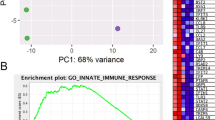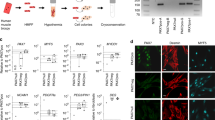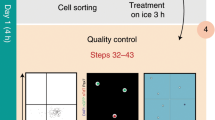Abstract
THE theory that injured skeletal muscle can regenerate by the formation of new cells although still disputed1 has strong support2–4. New muscle fibres are held to develop from multinucleate “myotubes” which are formed either by the budding of damaged muscle fibres or more probably by the fusion of mononuclear cells which have been termed “myoblasts”5–8. Walker insists that myoblasts multiply solely by mitotic division and derives them from injured adult muscle cells by dedifferentiation. Later cytoplasmic differentiation occurs mainly in myotubes and in these nuclear division is no longer seen. Others have claimed that myoblasts originate in connective tissue cells in or near the site of injury. It occurred to us, however, that like leucocytes and phagocytic histiocytes9 these muscle precursors could be carried in the circulation to injured areas from a central source, for example, the lymphoid tissues or bone marrow.
This is a preview of subscription content, access via your institution
Access options
Subscribe to this journal
Receive 51 print issues and online access
$199.00 per year
only $3.90 per issue
Buy this article
- Purchase on Springer Link
- Instant access to full article PDF
Prices may be subject to local taxes which are calculated during checkout
Similar content being viewed by others
References
Payling-Wright, G., in Proc. Second Symp. Res. in Muscular Dystrophy, 63 (edit. by Members of the Research Committee of the Muscular Dystrophy Group) (London, 1963).
Weber, C., Virchow's Arch. Path. Anat., 39, 216 (1867).
Durante, G., in Manuel d'Histologie Pathologique, third edit. (edit. by Cornil, V., and Ranvier, L.), 2, 1 (Paris, 1902).
Adams, R. D., Denny-Brown, D., and Pearson, C. M., Diseases of Muscle, second ed. 359 (London, 1962).
Lash, J. W., Holtzer, H., and Swift, H., Anat. Rec., 128, 679 (1957).
Pietsch, P., Anat. Rec., 139, 167 (1961).
Walker, B. E., Exp. Cell Res., 30, 80 (1963).
Sloper, J. C., and Pegrum, G. D., J. Path. Bact. (in the press, 1966).
Bintliff, S., and Walker, B. E., Amer. J. Pathol., 106, 233 (1960).
Clark, W. E. le Gros, J. Anat., 80, 24 (1946).
Hughes, W. L., Bond, V. P., Brecher, G., Cronkite, E. P., Painter, R. B., Quastler, H., and Sherman, F. G., Proc. U.S. Nat. Acad. Sci., 44, 476 (1958).
Moffat, G. M., and Pelc, S. R., Exp. Cell. Res., 42, 460 (1960).
Author information
Authors and Affiliations
Rights and permissions
About this article
Cite this article
BATESON, R., WOODROW, D. & SLOPER, J. Circulating Cell as a Source of Myoblasts in Regenerating Injured Mammalian Skeletal Muscle. Nature 213, 1035–1036 (1967). https://doi.org/10.1038/2131035a0
Issue Date:
DOI: https://doi.org/10.1038/2131035a0
This article is cited by
-
The muscle satellite cell at 50: the formative years
Skeletal Muscle (2011)
-
Cells that participate in regeneration of skeletal muscle
Gene Therapy (2002)
-
The ‘Fantastic Voyage’ of muscle progenitor cells
Nature Medicine (1998)
-
Muscle remodeling in adult snapping shrimps via fast-fiber degeneration and slow-fiber genesis and transformation
Cell & Tissue Research (1994)
-
Migration of myogenic cells in the rat extensor digitorum longus muscle studied with a split autograft model
Cell and Tissue Research (1990)
Comments
By submitting a comment you agree to abide by our Terms and Community Guidelines. If you find something abusive or that does not comply with our terms or guidelines please flag it as inappropriate.



